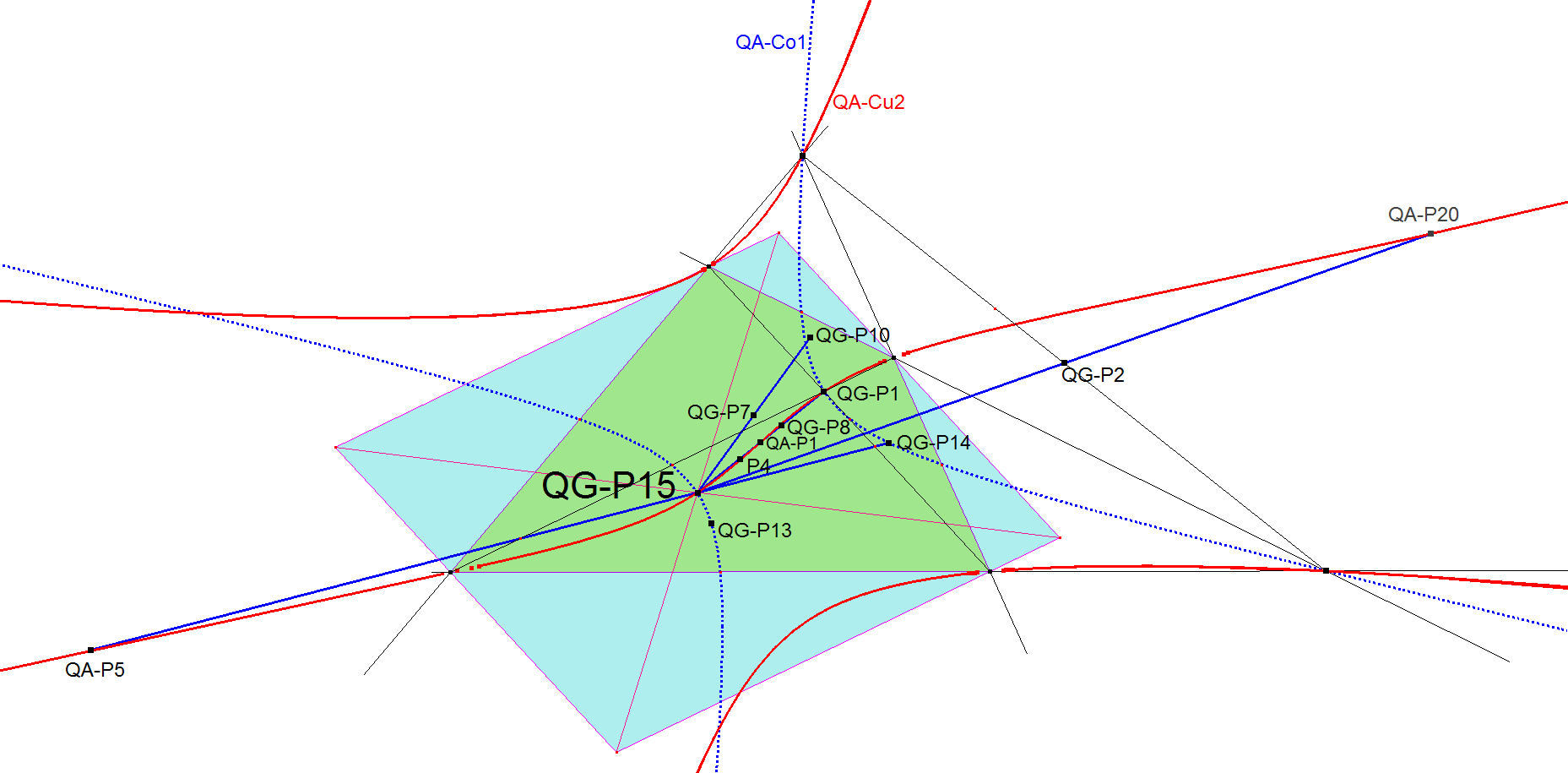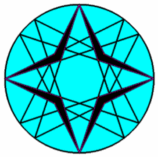QG-P15 Kirikami Center
QG-P15 is the center of the parallelogram defined by the lines parallel to the diagonals through the vertices of the quadrigon not on the diagonal.
This point was contributed by Seiichi Kirikami (August 11, 2012).

CT-Coordinates in 3 QA-Quadrigons
(p q + q2 – p r + q r : p2 + p q + p r – q r : (p + q) (p + q + 2 r))
(-p q + p r + q r + r2 : (p + r) (p + 2 q + r) : p2 + p q + p r – q r)
((q + r) (2 p + q + r) : -p q + p r + q r + r2 : p q + q2 – p r + q r)
CT-Coordinates in 3 QL-Quadrigons
(l (m – n) (l m – 2 m2 – l n + m n) : m (l2 m – l2 n – l n2 + m n2) : -(l – m) n (l m – 2 m2 – l n + m n))
(l (l m2 – m2 n + l n2 – m n2) : m (l – n) (-2 l2 + l m + l n – m n) : -(l – m) n (2 l2 – l m – l n + m n))
(l (m – n) (l m – l n – m n + 2 n2) : m (l – n) (l m – l n – m n + 2 n2) : n (-l2 m – l m2 + l2 n + m2 n))
CT-Area of QG-P1–Triangle in the QA-environment
2 p q r Δ / ((p + q) (p + r) (q + r))= area QA-Diagonal Triangle
CT-Area of QG-P1–Triangle in the QL-environment
0 (points are collinear]
—————————————————————————————————————
DT-Coordinates in 3 QA-Quadrigons
(-2 p2 (p2 – q2 – r2) : (p2 – q2 – r2) (p2 + q2 – r2) : -2 r2 (-p2 – q2 + r2))
(-(p2 + q2 – r2) (p2 – q2 + r2) : -2 q2 (-p2 + q2 – r2) : -2 r2 (-p2 – q2 + r2))
(2 p2 (p2 – q2 – r2) : 2 q2 (-p2 + q2 – r2) : -(p2 – q2 – r2) (p2 – q2 + r2))
DT-Coordinates in 3 QL-Quadrigons
(m2 (m – n) (m + n) : -(m2 – l n) (m2 + l n) : -(l – m) m2 (l + m))
(-(l2 – m n) (l2 + m n) : l2 (l – n) (l + n) : l2 (l – m) (l + m))
(-(m – n) n2 (m + n) : -(l – n) n2 (l + n) : (l m – n2) (l m + n2))
DT-Area of QG-P15-Triangle in the QA-environment
2S= area QA-Diagonal Triangle
DT-Area of QG-P15-Triangle in the QL-environment
0 (points are collinear]
Properties
- QG-P15 lies on these lines:
- QG-P15 is the Reflection of QG-P1 in QA-P1.
- QG-P15 is the Reflection of QG-P8 in QG-P4.
- QG-P15 is the Reflection of QG-P10 in QG-P7.
- QG-P15 is the Quasi Isogonal Conjugate (QG-Tf2) of QG-P16 (Schmidt Point). (Eckart Schmidt, November 26, 2012)
- The Involutary Conjugate (QA-Tf2) of QG-P15 is the Infinity Point of the Newton Line (QL-L1) in a Quadrigon.
- When the Quadrigon is convex, the area of the parallelogram = 2 x the area of the Reference Quadrigon.
- QG-P15 lies on one of the asymptotes of QG-Co3 (M3D Hyperbola).
- In a QL-Quadrigon QG-P15 is the 3rd intersection point of the QG-Co3 Hyperbolas of the other two QL-Quadrigons.
- The 3 QL-versions of QG-P15 are collinear on the line QL-L9 (M3D Line).
- The 3 QA-versions of QG-P15 form a triangle homothetic with QA-DT with homothetic center QA-P1. QA-P3 lies on its circumcircle.
- The 3 QA-versions of QG-P15 lie on the Nine-point Conic QA-Co1.
- The 3 QA-versions of QG-P15 lie on the cubic QA-Cu2.
- Area(Pi,Pi+1,QG-P15) = Area(Pi+2,Pi+3,QG-P15). See [34], QFG #357 by Eckart Schmidt.
- The Triple Triangle of QG-P15 is perspective with all QA-Component Triangles (see QA-Tr-1 for Desmic Triple Triangles).
Estimated human page views: 752
